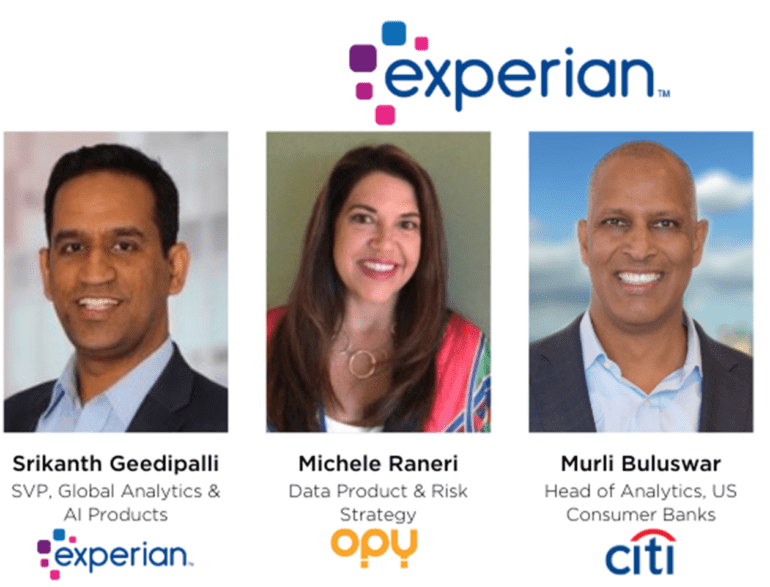In the biggest webinar of the new year, three credit experts went live Thursday in front of the LendIt audience to talk about the future of AI analytics in credit.
The cast was especially in demand by the LendIt audience. After a startling year of fintech startups and new products, it is refreshing to tie new tech back to credit and underwriting.
Srikanth Geedipalli, the SVP of Global analytics and AI at Experian, joined Michele Raneri, Data Product and Risk at the BNPL startup Opy, and Murli Buluswar, the head of Analytics US Consumer Banks at Citi. Host Peter Renton led the trio to explore the next generation of credit.
Geedipalli started by introducing himself and the panelists.
“Welcome to all our viewers today. I hope it’s been a good start to your new year,” Geedipalli said. “On my role: I’m the head of product for analytics products for the experienced global team. My mission here is to ‘productize’ analytics, which is a short way of saying, taking something that’s been a fairly long analytics project and transforming that into rapid, better, faster, and seamless solution delivery to our clients.”
How Experian deals with delinquencies and retains customers

Geedipalli, who was at McKinsey, Capital One, and BMO for more than 16 years before leading the Expiration AI product teams, said they use predictive tech and Machine Learning and Artificial Technology (MLAI) to help keep customers coming back.
Renton asked how the three dealt with pre, and post-charge offs and how MLAI helps delinquent accounts, but as Geedipalli explained, the past two years have seen a strong growth market without any trouble with delinquencies.
Instead, the problems in a bull market stem from keeping customers when there are so many other options.
“There’s a lot of opportunities on account management, around how do you keep them engaged, how do you ensure that when they get another card offer, they are not going away?”
Geedipalli also said the answer applied to the original question: “So thinking ahead, rather than reacting to it.”
Getting out in front of customers that are close to leaving, close to missing a payment, and offering them products and solutions that keep them on track, and most importantly, keep them in-house.
“So there’s a bunch of opportunities that just on just to close out and talk about specifically this question, right, so customers,” Geedipalli said.
“Users who are actually using the product and are close to a charge off or delinquency, they are both opportunities for the lenders for getting ahead of the problem right, offering solutions before they go into the delinquent state.”
Machine learning is required for credit models

Raneri has 30 years of experience leading consumer and business credit markets analytics at Citi and Experian and recently joined Opy. In this young BNPL fintech startup, she runs data and risk strategies.
She said she couldn’t comment on the most significant partnerships that would come out of the following year, her silence indicating a hopefulness that Opy will form a partnership in 2022, but she had a lot to say about AI analytics in BNPL.
Raneri is focused on building BNPL connections to customer checking accounts — Demand Deposit Accounts (DDAs.)
There are so many Americans with nontraditional finances, and building credit models for them requires innovation in data. A third of Americans work in the gig economy, and their income does not come regularly, Raneri said.
“I’ve had a lot of experience with that DDA data and building flow analytics. When you think about what your DDA looks like, what your checking account may look like, a lot of us have a regular income, salaries, and we get paid on a really regular basis,” Raneri said. “But what we found is there are so many people say in the gig economy or who get paid irregularly.”
Opy and anyone trying to build products has to develop models for calculating the new nontraditional market, and Raneri said the complexity required machine learning.
“Those attributes really needed this sophistication of machine learning so to have that much data and to still be able to develop attributes about the inflow and types of inflow and to be able to get more granular so that you can incorporate that into models,” Raneri said.
“It was absolutely fascinating. So if anybody is interested in doing that kind of cash flow analytics, machine learning would be the only way to do it because of so many different permutations people’s deviate out.”
On top means on the balls of your feet: Reacting to change

In 2020, call centers the world over shut down right when customers needed the support the most — that’s when Buluswar and the team initiated a predictive tech solution.
“How do we avoid a situation or mitigate the situation with customers having to hold for hours and hours,” Buluswar said. “What we had to do, based on customers’ digital behaviors, is predict who would call, why they would call, and find ways in which we could actually use advanced analytics to intercept their need to call.”
The models saved time in support, but the fundamental objective is to apply the saved time idea to everything: consumers need a suite for features that anticipate their needs quickly. For example, the regular six-month lead time on engineering new applications needs to shrink, Buluswar said.
“Our challenge really has been how to use increased speed and cycle time of insight generation and reduce the obvious friction that exists,” Buluswar said. “That cycle time has got to shrink fundamentally. It reduces that friction. It allows us to create a library of features that we can tap into. That’s the linchpin that is transforming the speed and sophistication through which my team is delivering insights.”
Predictions for the new year
Renton asked the three credit experts their takes on the most significant products coming in the new year in a final rapid-fire section at the end of the talk.
Srikanth: “Cash flow underwriting, using more data, using checking account data and transaction data into your underwriting models.”
Raneri: “Buy Now Pay Later,” and as a key regulatory theme: Continued focus on privacy in credit data.
Buluswar: “Connecting lender to the borrower much more efficiently, and facing the impact of increasing interest rates.”


